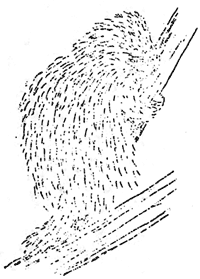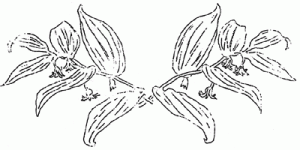A Friendly Porcupine
By Dale Leslie, Ranger Naturalist
The large hemlock forests of Crater Lake National Park are known to harbor many porcupines as evidence in various bark peeled trees. This rodent, living in both trees and ground, feeds upon the bark of the hemlock, which for him is a delicacy just as are the old scraps of leather, soap and other materials which he finds while raiding a deserted camp.

It is seldom, however, that a nature study group of tourists has the opportunity to study a living porcupine at close range. One morning while such a group was making its way over an old glacial moraine, a porcupine came from its hiding place beneath some of the large loose boulders a few feet from the party. Many of the startled tourists ran, believing in the old story that the creature would “shoot” its needles. This erroneous idea was soon forgotten when the porcupine, a slow moving fellow, worked his way over the rocks to a near-by hemlock which he proceeded to climb in his clumsy fashion, bracing himself with his broad tail.
In order to see most of the wild, roaming animal life of Crater Lake Park one must leave the immediate camp grounds along the Rim and travel the trails which lead into the forests. Here, where there are no dogs barking from the ends of their leashes, the natural denizens of the forest work and play unafraid.
Mineral Springs
By Earl U. Homuth
That volcanic action in the Crater Lake region has long since ceased may be indicated by the fact that no hot springs or fumeroles are know to exist. It is possible, however, that some may still be discovered, as many of the deeper canyons on the lower slopes of the mountain have not yet been thoroughly explored.
A recent discovery of several mineral springs in Annie Creek Canyon, by Chief Ranger Godfrey, is of importance in this respect. He states that in his experience this is the largest flow of mineral water to issue from a single spring. The walls below have been heavily stained from the fluid which is deep red in color, and which has a taste similar to that of the mineral springs in the vicinity of Ashland.
Specimen bottles have been sent to the laboratories for analysis.
Some Late Flowers
By F. Lyle Wynd
This late in the season the majority of the smaller varieties of wild flowers have disappeared. These early blooming species are nearly all annuals, while those flowers that now line the stream sides are chiefly perennials.
Of the latter, one of the most beautiful is the Pink Monkey Flower (Mimulus lewisii).Along the streams that flow through Castle Crest Garden great masses of them flourish. There are also three other kinds of Monkey Flower in bloom — all which are wheat in color.
The Monk’s Hood or Aconite (Aconitum columbianum) is another of these late flowers. It never occurs in masses, as does the Pink Monkey Flower, but is scattered throughout the vegetation of the damp places. Its deep blue blossoms are rather attractive, but the plant is one of the most poisonous in existence.
The swamps just below Park Headquarters abound in large patches of the Swamp Onion(Allium validum). This species is easily identified as it has the typical odor of onions, a characteristic of all members of the genus Allium.
The Pink Spiraea (Spiraea densiflora) is a prominent autumn shrub. Considerable thickets may be found near the streams of Castle Crest Garden.
In the deep forests of Mountain Hemlock, the Prince’s Pine or Pipsissewa (Chimaphila umbellata) with its clusters of pink flowers is likewise a common late summer shrub. This is small plant about eight inches in height. An examination of its structure shows it to be a member of the Heath Family.
***previous*** — ***next***


